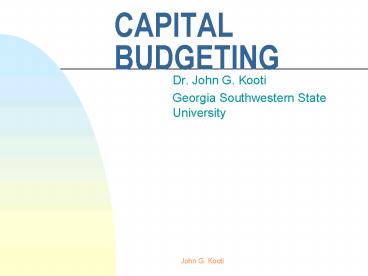CAPITAL BUDGETING PowerPoint PPT Presentation
1 / 18
Title: CAPITAL BUDGETING
1
CAPITAL BUDGETING
- Dr. John G. Kooti
- Georgia Southwestern State University
2
Should We Build this Plant?
- What is Capital Budgeting?
- Analysis of potential additions to fixed assets
- Long-term decisions, involve large expenditures
- Very important to firms future
3
Steps in Capital Budgeting
- Estimate Cash Flows (Inflows/Outflows)
- Assess Riskiness of Cash Flows (CFs)
- Determine Cost of Capital --Required Rate of
Return - Find NPV and/or IRR
- Accept or Reject Based on Criteria
4
Projects
- Mutually Exclusive Projects -- the acceptance of
one preclude the other. Example To get a
product across a river, you can either build a
bridge or transport by boat. If on project is
accepted, the other is rejected. - Independent Projects The acceptance of one does
not affect the other.
5
Projects
- Normal Project Cost (negative cashflows)
followed by a series of positive cash flows.
There is only one change in sign, either from
negative to positive or positive to negative. - Non-Normal Project Two or more change in signs.
Most common Cost (negative CFs), then a series
of positive CFs, then Cost of closing project.
Example Nuclear plant, strip mine.
6
Payback Period
- The number of years to recover a projects cost
or how long does it take to get our money back? 0
1 2
3 - -----------------------------------------------
-100 10 60
80 Cum-100 -90 -30
50 Payback Period 2 30/80 2.375 years
7
Payback Period
- Example 2 0 1 2 3 -------------------
------------------------------ -100 70 50
20 Cum-100 -30 20 40 Payback Period 1
30/50 1.60 years
8
Pay back Strength and Weakness
- Strengths
- It provides an indication of a project's risk and
liquidity - Easy to calculate and understand
- Weakness
- It ignores the Time Value of Money
- It ignores cash flows occurring after the payback
period
9
Discounted Payback
- Uses discounted rather than raw cash flows.
- Discounted payback considers the time value of
money, but it still fails to consider cash flows
after the payback period, therefore, it has basic
flaws. many firms still use payback period
because of emphasis of liquidity especially for
small projects.
10
Accounting Rate of Return (ARR)
- Focuses on the projects contribution to the
firms income rather than cash-flows. It is the
ratio of average annual expected net income to
average investment.
11
Net Present Value (NPV)
- NPV is the sum of the present value of a project
cash flows. for mutually exclusive projects, a
project is accepted that adds most to the value
of the firm. - Rules
- for independent projects accept if NPVgt0
- for mutually exclusive projects accept if
NPV1gtNPV2
12
Internal Rate of Return (IRR)
- IRR is the discount rate which forces the present
value of of a projects cash inflows to equal the
present value of its cash outflows. - An independent project is accepted if IRR is
greater than the cost of capital (k). - For mutually exclusive projects, a project is
accepted if IRR1 gt IRR2.
13
Profitability Index (PI)
- PI is the present value of cash inflows to
present value of cash outflows. It shows the
total dollar return per dollar of investment. - For independent projects Accept if PI is
greater than 1. - For mutually exclusive, accept the one with the
highest PI
14
NPV and IRR
- For independent projects both end up with same
decisions. - For mutually exclusive may not make the same
decisions. Net Present value is preferred.
15
NPV Profile
- NPV profile shows the relationship between NPV
and cost of capital. Two mutually exclusive
projects NPV profiles may crossover. If projects
does not crossover, then one project dominates
the other.
16
Why Crossover?
- Size (scale) differences--smaller projects frees
up funds at time 0 for reinvestment. The higher
the opportunity cost the more valuable these
funds, so higher k favors small projects. - 2. Timing differences--projects with faster
payback provide more CFs in early years for
reinvestment if k is high, early CFs especially
good.
17
Re-investment Rate Assumption
- NPV assumes re-investment at cost of capital (k)
- IRR assumes re-investment at IRR
- Re-investment at k is more realistic. Therefore,
NPV method is preferred to IRR method.
18
MIRR Method
- MIRR is better than IRR
- MIRR is the discount rate which causes the PV of
a project's terminal value (TV) to equal the PV
of costs. TV is found by compounding inflows at
WACC. Thus MIRR assumes cash inflows are
independent of WACC. - MIRR is better than IRR because it assumes
re--investment at k rather IRR. It also avoids
the problems of multiple IRR.

